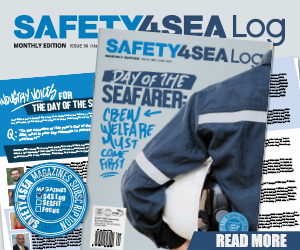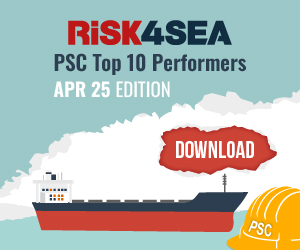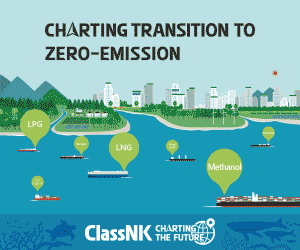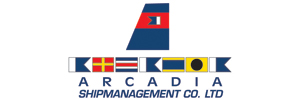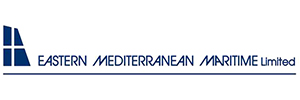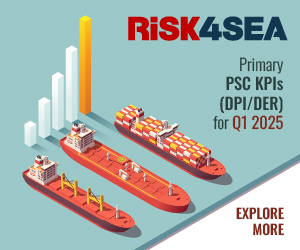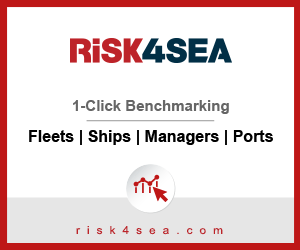Allianz Commercial has published its Safety and Shipping Review for 2025, which finds that the industry faces an increasingly volatile and complex operating environment, marked by attacks against shipping, vessel detentions, sanctions, as well as the fall-out from incidents involving damage to critical sub-sea cables.
Despite a continued decline in large losses, significant challenges persist. Shipowners are finding it increasingly challenging to operate safely amid evolving regulations, while also dealing with complex issues like conflicts, sanctions, tariffs, shadow fleet activity, and decarbonization pressures. In particular, Allianz notes that the shipping industry has made significant improvements when it comes to maritime safety in recent years. During the 1990s the global fleet was losing more than 200 vessels a year. This total had halved by 10 years ago and is now down to a record low of 27 as of the end of 2024.
The Allianz report highlights that political risk and conflict are becoming more relevant causes of maritime loss amid rising geopolitical tensions. While progress has been made in managing risks associated with large vessels, partial and attritional losses remain a major concern. Fires, collisions, and groundings still occur due to insufficient risk understanding and mitigation.
There is little doubt that the relevance of political risk and conflict as a potential cause of maritime loss is increasing with heightened geopolitical tensions.
…said Rich Soja, Global Head of Marine, Allianz Commercial.
Key data regarding losses:
- Total losses in 2024: 27
- Total losses between 2015 and 2024: 681
- Decline over the past decade: 75%
- Cargo, fishing and passenger vessels account for over 60% of ships lost over the past decade
- The average age of a vessel involved in a total loss over the past 10 years is 29
- Extreme weather was reported as being a factor in at least 7 losses during 2024
- Machinery damage/ failure accounted for well over half of all shipping incidents globally (56%), followed by vessel collision and fire/explosion.
The database shows 27 total losses of vessels over 100GT at the end of 2024, compared with 35 a year earlier and 105, 10 years previously. The South China, Indochina, Indonesia and the Philippines region is the main loss hotspot globally over the past year, together with the British Isles and the East Mediterranean and Black Sea (4 total losses each), and the past decade (169).
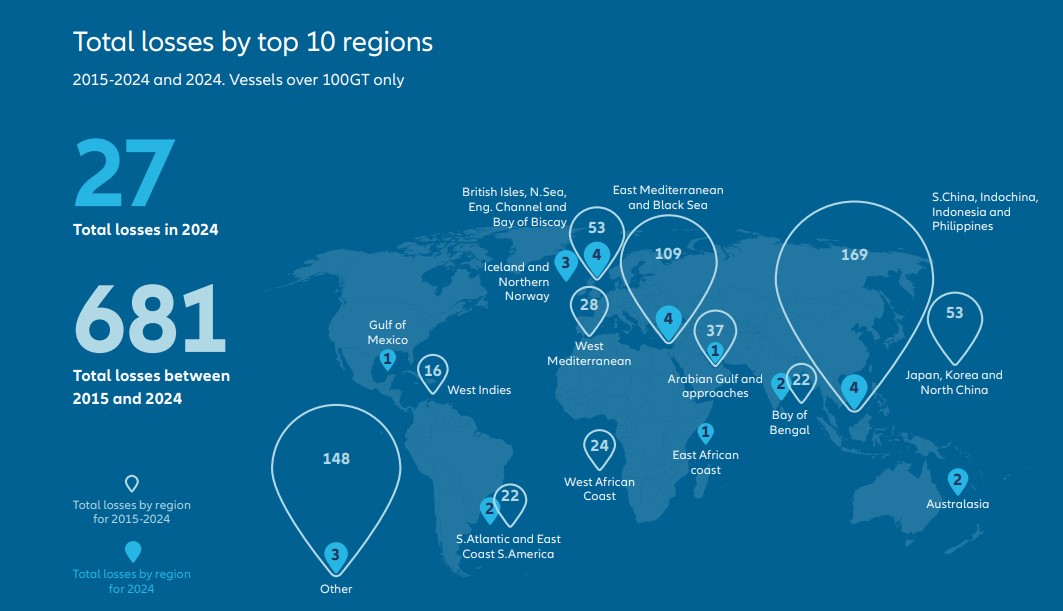
A huge volume of imports and exports flow through the region, resulting in high levels of shipping traffic, which is reflected in the number of incidents. Overall, the past decade has seen 681 total losses reported across the shipping world.
Furthermore, fishing vessels accounted for close to 40% of lost vessels during 2024 (10), followed by cargo (6) and chemical/product (3). Foundered (sunk) was the main cause of total loss across all vessel types (12), accounting for close to 50%. Fire/explosion ranked second (7), remaining stable with fishing vessels the main casualties. More than 100 total losses of vessels have been caused by fires in the past decade.
The number of reported shipping casualties or incidents around the world increased by around 10% during 2024 (3,310 compared to 2,963). The British Isles saw the highest number (799), followed by the East Mediterranean and Black Sea (694).
The British Isles is also the top location for the most incidents over the past decade (5,613), accounting for 20% of 28,331 reported incidents. Machinery damage/failure accounted for well over half of all shipping incidents globally (1,860) in 2024, followed by vessel collision (251) and fire/explosion. There were 250 fire incidents during 2024, up by 20% year-on-year, the highest total for a decade.
Shipping choke points come under fire
Strategic shipping routes and choke points are increasingly being politicized as geopolitical and regional tensions rise. Transits through the Suez Canal have been severely curtailed by Houthi attacks against shipping in the Red Sea, while tensions between China, the US and South East Asian countries over territorial disputes raise the prospect of future disruption to shipping in the South China Sea, which carries one-third of global shipping. Meanwhile, Arctic waters have become focal points of international tension, with countries seeking control over emerging trade routes as ice melts.
Heightened geopolitical risks could, conceivably, see potential future conflicts in several key trade routes, including the Red Sea, South China Sea and the Baltic Sea.
…said Justus Heinrich, Global Product Leader, Marine Hull, Allianz Commercial.
Red Sea threat to shipping likely to continue
A tentative ceasefire between Israel and Hamas in January 2025 raised hopes of a gradual return to transits through the Suez Canal and Red Sea in 2025. However, with the resumption of the war in March 25, followed by the US recommencing its own attacks against the Houthis – and the Houthis retaliating – the security threat posed to one of the world’s busiest shipping routes is likely to remain, even in light of another ceasefire being reported in May 2025, which raised hopes that the Houthis will stop targeting shipping in the region.
The number of vessels transiting the Bab-al-Mandab Strait in February 2025 was 50% down on pre-Red Sea crisis levels, with Egypt’s president estimating losses to the economy of $800 million a month.
US-China trade conflict and growing shadow fleet bring uncertainty and challenges
China has been the biggest target of the protectionist measures of the US administration with tariffs reaching 145%, before both countries agreed to reduce them for 90 days. Developments have significantly impacted global maritime trade with approximately 18% of it subject to tariffs as of mid-April 2025, compared with 4% in early March, and dramatic declines in shipments reported in the immediate aftermath of the “Liberation Day” announcements.
While the future of US trade-focused policies remains uncertain, another phenomenon is posing an increasing challenge for the maritime and insurance industry: the shadow fleet. Since the start of the war in Ukraine, the size of the shadow fleet has grown significantly. Today, around 17% of the world tanker fleet is thought to belong to the shadow fleet: estimates indicate there are close to 600 tankers trading Russian oil alone. Shadow fleet vessels have been involved in tens of incidents around the world including fires, collisions and oil spills.
“Although recent sanctions are making it harder for these vessels to trade, the shadow fleet continues to pose a serious risk to maritime safety and the environment, as many are likely to be older vessels that are poorly maintained and inadequately insured. In case of an oil spill involving a shadow fleet tanker, cleanup costs could be as much as US$1.6bn, most likely to be paid by taxpayers,” says Justus Heinrich, Global Product Leader, Marine Hull, Allianz Commercial.
Cargo theft on the rise: increase in fraudulent documentation and false identity-related claims
The frequency of theft claims is causing higher loss ratios for some cargo insurers, with repeated thefts of shipments valued up to $1 million leading to significant losses. Criminals are becoming more sophisticated, using fraudulent documentation and false identities to access high-value cargo, shifting from opportunistic to targeted theft.
Climate transition trends
Decarbonization of shipping, which generates 3% of global greenhouse gas emissions, is seen as vital to global efforts to address climate change.
According to Captain Rahul Khanna, Global Head of Marine Risk Consulting, Allianz Commercial. “On one hand sustainability efforts and commitments in large parts of the world continue to increase, but we also now have contrasting views on climate change and the energy transition, which will only increase uncertainty for shipowners, who will be planning investments and placing orders for vessels that will be delivered and operating in the years and decades ahead”.
In this context, the report identifies the following trends concerning the climate transition
#1 Decarbonization: charting a course through uncertain waters
Allianz notes that despite the uncertainty, the shipping industry will continue on its decarbonization trajectory, given there are many factors driving the energy transition, and a large part of the world is still aligned on the need to work towards net zero targets.
#2 Transparency key to addressing risks of alternative fuels









































